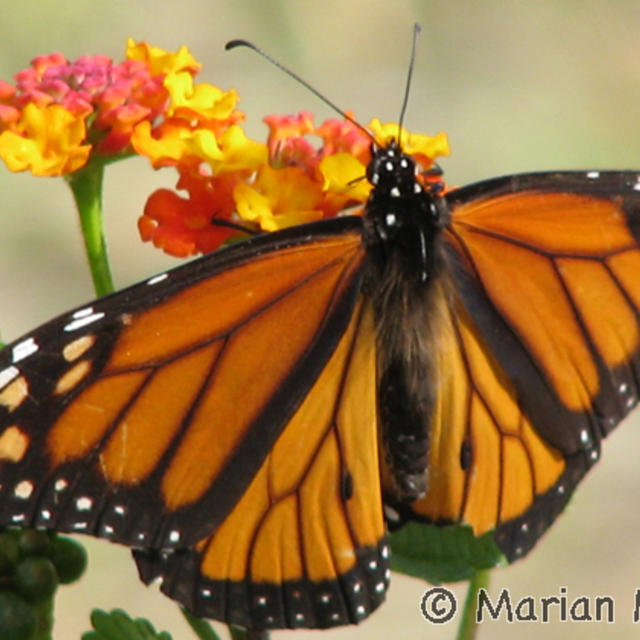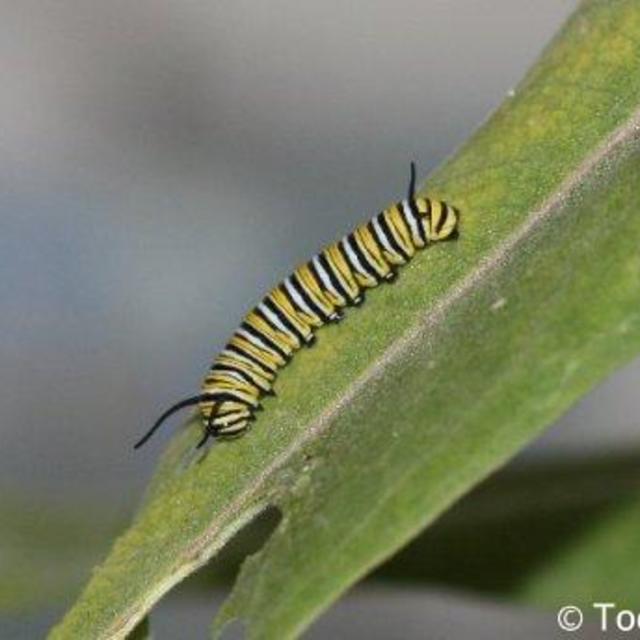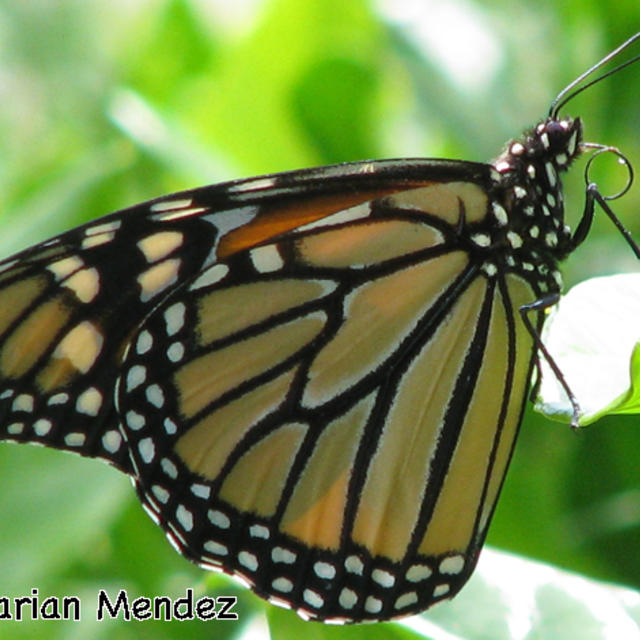Monarch
Danaus plexippus (Linnaeus, 1758)
Family: Nymphalidae
Subfamily: Danainae
Identification: Upperside of male is bright orange with wide black borders and black veins; hindwing has a patch of scent scales. Upperside of female is orange-brown with wide black borders and blurred black veins. Both sexes have white spots on borders and apex. The Viceroy butterfly (Limenitis archippus) is a Mullerian mimic; it has similar coloration and is also distasteful.
Wing Span: 3 3/8 - 4 7/8 inches (8.6 - 12.4 cm).
Life History: Adults warm up by basking dorsally (with their wings open and toward the sun). Females lay eggs singly under the host leaves; caterpillars eat leaves and flowers. Adults make massive migrations from August-October, flying thousands of miles south to hibernate along the California coast and in central Mexico. A few overwinter along the Gulf coast or south Atlantic coast. Along the way, Monarchs stop to feed on flower nectar and to roost together at night. At the Mexico wintering sites, butterflies roost in trees and form huge aggregations that may have millions of individuals. During the winter the butterflies may take moisture and flower nectar during warm days. Most have mated before they leave for the north in the spring, and females lay eggs along the way. Residents of tropical areas do not migrate but appear to make altitude changes during the dry season.
Flight: In North America during spring and summer there may be 1-3 broods in the north and 4-6 broods in the south. May breed all year in Florida, South Texas, and southeastern California.
Caterpillar Hosts: Milkweeds including common milkweed (Asclepias syriaca), swamp milkweed (A. incarnata), and showy milkweed (A. speciosa); and milkweed vine in the tropics. Most milkweeds contain cardiac glycosides which are stored in the bodies of both the caterpillar and adult. These poisons are distasteful and emetic to birds and other vertebrate predators. After tasting a Monarch, a predator might associate the bright warning colors of the adult or caterpillar with an unpleasant meal, and avoid Monarchs in the future.
Adult Food: Nectar from all milkweeds. Early in the season before milkweeds bloom, Monarchs visit a variety of flowers including dogbane, lilac, red clover, lantana, and thistles. In the fall adults visit composites including goldenrods, blazing stars, ironweed, and tickseed sunflower.
Habitat: Many open habitats including fields, meadows, weedy areas, marshes, and roadsides.
Range: Southern Canada south through all of the United States, Central America, and most of South America. Also present in Australia, Hawaii, and other Pacific Islands.
Conservation: Overwintering sites in California and Mexico should be protected and conserved.
NCGR: G5 - Demonstrably secure globally, though it may be quite rare in parts of its range, especially at the periphery.
Management Needs: Develop conservation and management plans for all wintering sites, migration corridors, and principal breeding areas.
Get your BAMONA Gear!
Please donate!
We depend on donations to keep Butterflies and Moths of North America freely available. We want to express our gratitude to all who showed their support by making a contribution this year. You can donate to support this project at any time.
Advertise with us!
Do you have a product or service that you think would interest BAMONA users? If you would like to advertise on this website, contact us by email, or use the contact form and select the "Advertising" category.
Verified Sightings
Displaying 49 - 72 of 18689 verified sightings

Observation date: Oct 02, 2024
Submitted by: Sheilabean
Region: Texas, Tarrant County, United States
Verified by: jwileyrains
Verified date: Oct 08, 2024

Observation date: Oct 02, 2024
Submitted by: Sheilabean
Region: Texas, Tarrant County, United States
Verified by: jwileyrains
Verified date: Oct 08, 2024

Observation date: Sep 06, 2024
Submitted by: pgrew1@unl.edu
Region: Penobscot County, Maine, United States
Verified by: John Calhoun
Verified date: Oct 07, 2024

Observation date: Sep 20, 2024
Submitted by: COA1955
Region: Morgan County, Colorado, United States
Verified by: mikefisher
Verified date: Oct 07, 2024

Observation date: Oct 07, 2024
Submitted by: cas9322
Region: Williamson County, Tennessee, United States
Verified by: James Steen
Verified date: Oct 07, 2024

Observation date: Oct 05, 2024
Submitted by: Colleen K
Region: Robertson County, Tennessee, United States
Verified by: James Steen
Verified date: Oct 05, 2024

Observation date: Oct 02, 2024
Submitted by: TientsinMama
Region: Chatham County, North Carolina, United States
Verified by: rogerdowner
Verified date: Oct 04, 2024

Observation date: Sep 29, 2024
Submitted by: Sheilabean
Region: Texas, Tarrant County, United States
Verified by: jwileyrains
Verified date: Oct 03, 2024

Observation date: Sep 30, 2024
Submitted by: Sheilabean
Region: Texas, Tarrant County, United States
Verified by: jwileyrains
Verified date: Oct 03, 2024

Observation date: Oct 02, 2024
Submitted by: Sheilabean
Region: Texas, Tarrant County, United States
Verified by: jwileyrains
Verified date: Oct 03, 2024

Observation date: Oct 02, 2024
Submitted by: Sheilabean
Region: Texas, Tarrant County, United States
Verified by: jwileyrains
Verified date: Oct 03, 2024

Observation date: Oct 02, 2024
Submitted by: ObserverofGod'sart
Region: Bexar County, Texas, United States
Verified by: jwileyrains
Verified date: Oct 02, 2024

Observation date: Oct 01, 2024
Submitted by: yxsaturniid
Region: Bristol County, Massachusetts, United States
Verified by: jwileyrains
Verified date: Oct 01, 2024

Observation date: Sep 29, 2024
Submitted by: houdini73
Region: Brown County, Texas, United States
Verified by: jwileyrains
Verified date: Oct 01, 2024

Observation date: Oct 01, 2024
Submitted by: James Steen
Region: Harper County, Kansas, United States
Verified by: James Steen
Verified date: Oct 01, 2024

Observation date: Sep 30, 2024
Submitted by: cjgoin
Region: Doña Ana County, New Mexico, United States
Verified by: stevecary
Verified date: Oct 01, 2024

Observation date: Sep 28, 2024
Submitted by: Sheilabean
Region: Texas, Tarrant County, United States
Verified by: jwileyrains
Verified date: Sep 29, 2024

Observation date: Sep 28, 2024
Submitted by: Sheilabean
Region: Texas, Tarrant County, United States
Verified by: jwileyrains
Verified date: Sep 29, 2024

Observation date: Sep 28, 2024
Submitted by: Sheilabean
Region: Texas, Tarrant County, United States
Verified by: jwileyrains
Verified date: Sep 29, 2024

Observation date: Sep 22, 2024
Submitted by: Safleming
Region: Hamilton County, New York, United States
Verified by: jmgesell
Verified date: Sep 28, 2024

Observation date: Sep 25, 2024
Submitted by: mtobin11
Region: Lake County, Illinois, United States
Verified by: rogerdowner
Verified date: Sep 28, 2024

Observation date: Sep 26, 2024
Submitted by: mtobin11
Region: Lake County, Illinois, United States
Verified by: rogerdowner
Verified date: Sep 28, 2024

Observation date: Sep 27, 2024
Submitted by: Christinalea
Region: Texas, Wichita County, United States
Verified by: jwileyrains
Verified date: Sep 27, 2024

Observation date: Sep 26, 2024
Submitted by: psmith
Region: Montgomery County, Pennsylvania, United States
Verified by: davidwright
Verified date: Sep 27, 2024
- ‹ previous
- 3 of 779
- next ›























